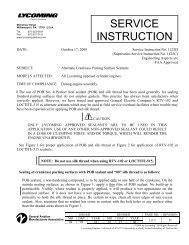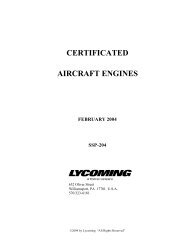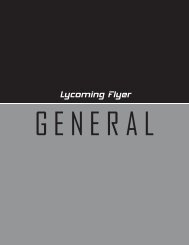SERVICE INSTRUCTION - Textron Lycoming
SERVICE INSTRUCTION - Textron Lycoming
SERVICE INSTRUCTION - Textron Lycoming
Create successful ePaper yourself
Turn your PDF publications into a flip-book with our unique Google optimized e-Paper software.
Section B Unleaded Automotive Fuels<br />
This Section B supplies critical details on the use of automotive fuel in aircraft engines.<br />
Premium or Super Premium grade unleaded automotive gasoline fuels meeting the requirements identified<br />
in Table B1 of this Service Instruction are approved for use only on the engine models listed in Table B2.<br />
Usage of automotive gasoline that does not conform to the parameters described in Tables B1 and B2 is<br />
not permitted.<br />
Background<br />
CAUTION<br />
Automotive ground transportation fuels available direct to consumers (e.g. “pump gas”) are<br />
typically not labeled sufficiently to determine compliance with the requirements stipulated<br />
in Table B1. While indicated octane is generally required for display at retail points of sale,<br />
octane rating methods, fuel vapor pressure, oxygenate content and ethanol content can vary<br />
widely and are generally known only at the wholesale terminal. To ensure compliance with<br />
Service Instruction No. 1070Q, all parameters listed in Table B1 must be satisfied.<br />
Automotive ground transportation fuels have previously been prohibited for use in all <strong>Lycoming</strong> engines.<br />
The primary reason for this prohibition is the fact that ground transportation fuels (gasoline and diesel) are<br />
generally formulated to optimize engine emissions and easeofstarting. These formulations are heavily<br />
influenced by environmental regulations and vary by geographic region and season.<br />
Automotive fuel specifications have evolved in recent years such that ASTM/EN standard fuel ordering<br />
parameters may be utilized to stipulate the necessary properties to enable usage as an aviation fuel for<br />
aircraft engines with low octane requirements. The control parameters that must be specified and examined<br />
for compliance in aviation use are the same as the parameters that must be specified in automotive ground<br />
transport use.<br />
Description<br />
NOTE<br />
Although the automotive fuel listed in Table B1 is approved for use in the <strong>Lycoming</strong><br />
engine models listed in Table B2, further approval is required via a Supplemental Type<br />
Certificate (STC) or Type Certificate (TC) to permit the use of this fuel in the airframe.<br />
The clear, colorless unleaded automotive fuels listed in Table B1 must conform to ASTM D481409b or<br />
EN 228:2008:E. In these specifications, the automotive fuel is classified by an AntiKnock Index (AKI) or<br />
in the case of EN228 Super Premium, a grade designation. The AKI is an octane rating and is the arithmetic<br />
average of the Research Octane Number (RON) and Motor Octane Number (MON).<br />
(RON + MON)/2 = AKI<br />
The AKI or EN228 grade value must be as specified in Table B2 or higher. The AKI or grade value is<br />
critical to engine performance. Table B 2 lists the selected <strong>Lycoming</strong> engine models and the minimum AKI<br />
or grade requirement.<br />
As per ASTM D481409b, the vapor pressure of the fuel must be rated as Class A4 for vapor lock<br />
protection. The letter “A” in this rating refers to the volatility of the fuel and the number specifies the vapor<br />
lock protection class. The ASTM D481409b maximum vapor pressure limit is 9.0 psi (0.62 kPa) maximum<br />
for a Class A rating. Vapor lock can occur at high operating temperatures resulting in diminished fuel flow<br />
to the engine causing loss of engine power, rough engine operation, or engine stoppage.<br />
ISSUED REVISED PAGE NO. REVISION<br />
MO<br />
11<br />
DAY<br />
09<br />
YEAR<br />
62<br />
MO<br />
07<br />
DAY<br />
16<br />
YEAR<br />
10<br />
5 of 6 Q S.I. 1070







